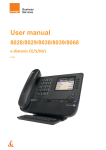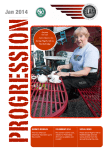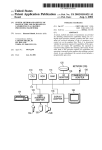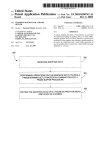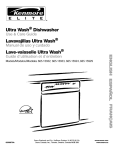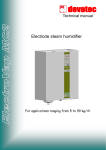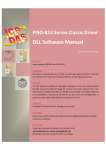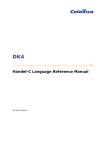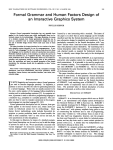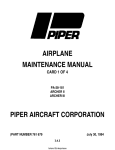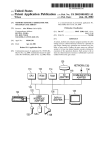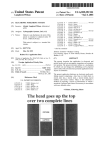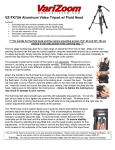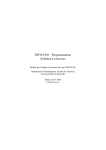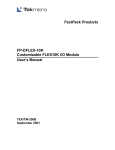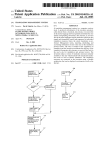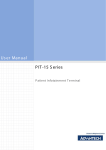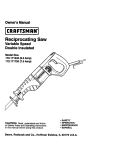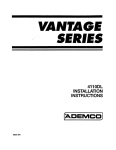Download System, method and article of manufacture for a single
Transcript
US 20030023653A1
(19) United States
(12) Patent Application Publication (10) Pub. No.: US 2003/0023653 A1
(43) Pub. Date:
Dunlop et al.
(54) SYSTEM, METHOD AND ARTICLE OF
Jan. 30, 2003
Publication Classi?cation
MANUFACTURE FOR A SINGLE-CYCLE
FLOATING POINT LIBRARY
(76) Inventors: Andrew Dunlop, Oxford (GB); James
J. Hrica, Los Gatos, CA (US)
(51)
Int. Cl? ..................................................... .. G06F 7/38
(52)
Us. 01. ............................................................ ..708/551
(57)
ABSTRACT
A system, method and article of manufacture are provided
for improved efficiency during the execution of ?oating
point applications. Initially, a ?oating point application is
Correspondence Address:
CARLTON FIELDS, PA
provided Which includes a ?oating point library. HardWare
PO. BOX 3239
is then built based on the ?oating point application. Com
TAMPA, FL 33601-3239 (US)
puter code of the ?oating point application shares compo
(21) App1.No.:
09/772,524
nents selected from the group consisting of multipliers,
dividers, adders and subtractors for minimizing an amount
(22) Filed:
Jan. 29, 2001
of the hardWare to be constructed.
200
2ON
PROVIDING A FLOATING POINT APPLICATION WRITTEN USING A
FLOATING POINT LIBRARY
CONSTRUCTING HARDWARE BASED ON THE FLOATING POINT
APPLICATION
V
WHEREIN COMPUTER CODE OF THE FLOATING POINT
APPLICATION SHARES MULTIPLIERS AND ADDERS FOR
MINIMIZING AN AMOUNT OF THE HARDWARE TO BE
CONSTRUCTED
Patent Application Publication
Jan. 30, 2003 Sheet 1 0f 7
US 2003/0023653 A1
120
110
\
116
\
114
\
@ 118 NETWORK
(135)
‘X 134
I
112
122
IO
/
COMMUNICATION
13a
\ 1
\
|NTLEEE§CE
DISPLAY
132/% 126% 128
Fig. 1
Patent Application Publication
Jan. 30, 2003 Sheet 2 0f 7
US 2003/0023653 A1
200
K
202
PROVIDING A FLOATING POINT APPLICATION WRITTEN USING A _/
FLOATING POINT LIBRARY
204
CONSTRUCTING HARDWARE BASED ON THE FLOATING POINT
APPLICATION
V
WHEREIN COMPUTER CODE OF THE FLOATING POINT
APPLICATION SHARES MULTIPLIERS AND ADDERS FOR
MINIMIZING AN AMOUNT OF THE HARDWARE TO BE
CONSTRUCTED
Fig. 2
206
Patent Application Publication
Jan. 30, 2003 Sheet 3 of 7
US 2003/0023653 A1
300
S 6€6€66€€ mrnmm . . .
. . . l'IlIIlIIl
1 sign b1t8 exponent bits (twr-
23 mantissa bits (swr
swri
U
hidden 1
Fig. 3
Patent Application Publication
Jan. 30, 2003 Sheet 4 0f 7
Purpose
Values
FLOAT_EXTRA__PREC
US 2003/0023653 A1
O < integer < 24
Extra precision bits to use for single precision
operations.
DOUBLE_EXTRA_PREC
O < integer < 53
Extra precision bits to use for double precision
operations
Fig. 4
400
Patent Application Publication
Jan. 30, 2003 Sheet 5 0f 7
US 2003/0023653 A1
Macro Name
Type
Purpose
h¢2fP1_<=OnStru¢tFl°at_w
eXPr
Constructs a ?oating-point number of any width from a sign bit,
an exponent, and a mantissa. (The mantissa width inputted
must exclude the hidden 1).
h¢2fP1_abS
hCZfPLnQQatE
11¢2fPl._r-Shi fl’-
eXPr
eXPr
expr
eXPr
Gets the absolute (positive) value of the input.
Gets the negative value of the input.
Left shift, equivalent to << for integers.
Right shift, equivalent to» for integers.
hc2ft>l_round
eXPr
hczfpLlshift
Rounds a ?oating-point number with signi?cand width swi to on
with signi?cand width swr.
hc2fpl_<=onvert
eXPr
Converts a ?oating-point number with signi?cand width swi to z
?oat of total width twr and signi?cand width swr.
h¢2 fPl_mul_w
eX1?r
Mul?plies two ?oats and outputs a ?oat of total width twr and
signi?cand width swr.
Multiplies two single precision ?oats.
Multiplies two double precision ?oats.
h¢2 fpl_mul_float
hczfplmuljouble
eXPr
expr
h¢2fPl_add_w
expr
Adds two ?oats and outputs a ?oat of total width twr and
signi?cand width swr.
h¢2fp1_add_1ar9e
eXPr
Adds two ?oats of width sw and outputs a ?oat of width sw. Thi:
macro is larger but faster than hc2fpl_add_w.
hc2fpl_add_float
eXPr
Adds two single precision ?oats.
hCZ fpljddjouble
eXPr
Adds two double precision ?oats.
hCZ fPl_5ub_w
eXPr
Subtracts one ?oat from another and outputs a ?oat of total
width twr and signi?cand width swr.
h<=2fpl_sub_large
eXPr
Subtracts one ?oat of width swfrom another and outputs a ?oa
11¢2fPl_5‘-1b_f1°at
eXPr
Subtracts one single precision ?oat from another.
hc2fpl_sub_double
hc2fpl_<ilv_w
eXPr
1pmC
Subtracts one double precision ?oat from another
Divides two ?oats and outputs the quotient with mantissa width
hc2fpl_div_float
PIQC
Divides a single precision ?oat by another.
hCZ fpljivjiwble
Proc
hCZfPLSqILW
Proc
Divides a double precision ?oat by another.
Outputs the square root of the input with signi?cand width swr.
hczfpksqrtfloat
P1’0C
Finds the square root of a single precision ?oat.
hczfpljqrtadouble
Proc
Finds the square root of a double precision ?oat.
hc2fpl_ulnt2fp
eXPr
of width sw. This macro is larger but faster than the above.
swr.
Converts an unsigned integer into a ?oating point number of
width tw and signi?cand width sw.
11C2fP1_1nt2fP
eXPr
Converts a signed integer into a ?oating point number of width
tw and signit'icand width sw.
hCZfPIJPZHiRC
eXPr
Converts a ?oating-point number into an unsigned int of width
wi.
h<:2fpl_fP2mt
eXPr
Converts a ?oating point number into a signed int of width wi
Fig. 5
500
Patent Application Publication
Jan. 30, 2003 Sheet 6 0f 7
Float Length I
Clock Speed
Size -
Exponent Length Bits
MHz
No. of
Gates
Smgle Precision
15.7
6.3
Double Precision
341 1
16761
F|g. 6
Float Length I
Clock Speed
Size — No.
Exponent Length Bits
Single Precis|on
Double Precision
MHz
15.06
8.2
of Gates
1899
4511
F|g . 7
Float Length I
Exponent Length Bits
Single Precision
Clock Speed
MHz
16.8
Size- No.
of Gates
4621
Double Precision
9.7
11522
F lg . 8
Float Length I
Clock
Clock
Size -
Exponent
Speed
Cycles
No. of
Gates
Length Bits
MHz
to result
Single Precision
23.4
27
798
Double
13.25
56
1836
Precision
Fig. 9
US 2003/0023653 A1
Patent Application Publication
Jan. 30, 2003 Sheet 7 0f 7
Float Length I
Clock
Clock
US 2003/0023653 A1
Size -
Exponent
Speed
Cycles
No. of
Length Bits
MHz
to result
Gates
Single Precision
Double
Precision
27.4
16.7
28
57
534
1092
Fig. 10
Jan. 30, 2003
US 2003/0023653 A1
SYSTEM, METHOD AND ARTICLE OF
MANUFACTURE FOR A SINGLE-CYCLE
FLOATING POINT LIBRARY
[0007] While ?oating point libraries have been established
in the softWare domain, there is still a continuing need for
effective handling of ?oating point numbers in hardWare.
FIELD OF THE INVENTION
SUMMARY OF THE INVENTION
[0001] The present invention relates to ?oating point
applications and more particularly to providing improved
provided for improved ef?ciency during the execution of
ef?ciency during the execution of ?oating point applica
?oating point applications. Initially, a ?oating point appli
tions.
cation is provided Which includes a ?oating point library.
HardWare is then built based on the ?oating point applica
tion. Computer code of the ?oating point application shares
components selected from the group consisting of multipli
BACKGROUND OF THE INVENTION
[0002] It is Well knoWn that softWare-controlled machines
provide great ?exibility in that they can be adapted to many
different desired purposes by the use of suitable softWare. As
Well as being used in the familiar general purpose comput
ers, softWare-controlled processors are noW used in many
products such as cars, telephones and other domestic prod
ucts, Where they are knoWn as embedded systems.
[0003] HoWever, for a given function, a softWare-con
trolled processor is usually sloWer than hardWare dedicated
to that function. AWay of overcoming this problem is to use
a special softWare-controlled processor such as a RISC
processor Which can be made to function more quickly for
limited purposes by having its parameters (for instance siZe,
instruction set etc.) tailored to the desired functionality.
[0008]
A system, method and article of manufacture are
ers, dividers, adders and subtractors for minimiZing an
amount of the hardWare to be constructed.
[0009] In one embodiment of the present invention, the
components are used on a single clock cycle. For example,
the ?oating point library includes single-clock cycle macros
for multiplication, add, subtract, negation, shifting, round
ing, Width conversion (?oat Width 23 to ?oat 32), and/or type
conversion (?oat to int,etc.) operations. Multiple clock cycle
macros are also provided for divide and square root opera
tions.
[0010] In another embodiment of the present invention, a
Width of the output of the computer code may be user
speci?ed. Width conversion can be done manually by calling
[0004] Where hardWare is used, though, although it
increases the speed of operation, it lacks ?exibility and, for
a FloatConvert macro prior to the operation. As an option, it
may be decided that all macros output results of the same
instance, although it may be suitable for the task for Which
Width as the input in order to be consistent With integer
operators. In one aspect of the present invention, the com
it Was designed it may not be suitable for a modi?ed version
of that task Which is desired later. It is noW possible to form
the hardWare on recon?gurable logic circuits, such as Field
Programmable Gate Arrays (FPGA’s) Which are logic cir
cuits Which can be repeatedly recon?gured in different Ways.
Thus they provide the speed advantages of dedicated hard
Ware, With some degree of ?exibility for later updating or
multiple functionality.
[0005] In general, though, it can be seen that designers
face a problem in ?nding the right balance betWeen speed
and generality. They can build versatile chips Which Will be
softWare controlled and thus perform many different func
tions relatively sloWly, or they can devise application
speci?c chips that do only a limited set of tasks but do them
much more quickly.
[0006] As is knoWn in the art, a ?oating point number may
be represented in binary format as an exponent and a
mantissa. The exponent represents a poWer to Which a base
number such as 2 is raised and the mantissa is a number to
be multiplied by the base number. Accordingly, the actual
number represented by a ?oating point number is the man
tissa multiplied by a quantity equal to the base number raised
to a poWer speci?ed by the exponent. In such a manner, any
particular number may be approximated in ?oating point
notation as f><Be or (f,e) Where f is an n-digit signed
mantissa, e is an m-digit signed integer exponent and B is the
base number system. In most computer systems, the base
number system used is the binary number system Where
B=2, although some systems use the decimal number system
(B=10) or the hexadecimal number system (B=16) as their
puter code may be programmed using Handel-C.
BRIEF DESCRIPTION OF THE DRAWINGS
[0011]
The invention Will be better understood When con
sideration is given to the folloWing detailed description
thereof Such description makes reference to the annexed
draWings Wherein:
[0012] FIG. 1 is a schematic diagram of a hardWare
implementation of one embodiment of the present invention;
[0013]
FIG. 2 illustrates a method by Which Handel-C
may be used for providing improved ef?ciency during the
execution of ?oating point applications;
[0014] FIG. 3 illustrates a form of output including a
structure, in accordance With one embodiment of the present
invention;
[0015] FIG. 4 illustrates the Handel-C de?nitions that
may be used for implementation of the present invention;
[0016]
FIG. 5 illustrates various macros Which may be
used for implementation of the present invention; and
[0017] FIGS. 6-10 illustrate various tables delineating the
performance of the present invention.
DETAILED DESCRIPTION OF THE
PREFERRED EMBODIMENTS
[0018] Apreferred embodiment of a system in accordance
With the present invention is preferably practiced in the
base number system. Floating point numbers may be added,
context of a personal computer such as an IBM compatible
subtracted, multiplied, or divided and computing structures
personal computer, Apple Macintosh computer or UNIX
based Workstation. A representative hardWare environment
is depicted in FIG. 1, Which illustrates a typical hardWare
for performing these arithmetic operations on binary ?oating
point numbers are Well knoWn in the art.
Jan. 30, 2003
US 2003/0023653 A1
functions as de?ned by user-provided con?guration
instructions stored in the con?guration-de?ning
con?guration of a Workstation in accordance With a pre
ferred embodiment having a central processing unit 110,
such as a microprocessor, and a number of other units
interconnected via a system bus 112. The Workstation shoWn
in FIG. 1 includes a Random Access Memory (RAM) 114,
Read Only Memory (ROM) 116, an I/O adapter 118 for
connecting peripheral devices such as disk storage units 120
to the bus 112, a user interface adapter 122 for connecting
a keyboard 124, a mouse 126, a speaker 128, a microphone
memory means.
[0025] Typically, each of the many CLB’s of an FPGA has
at least one lookup table (LUT) that is user-con?gurable to
de?ne any desired truth table,—to the extent alloWed by the
address space of the LUT. Each CLB may have other
resources such as LUT input signal pre-processing resources
132, and/or other user interface devices such as a touch
and LUT output signal post-processing resources. Although
the term ‘CLB’ Was adopted by early pioneers of FPGA
screen (not shoWn) to the bus 112, communication adapter
technology, it is not uncommon to see other names being
134 for connecting the Workstation to a communication
given to the repeated portion of the FPGA that carries out
user-programmed logic functions. The term, ‘LAB’ is used
netWork (e.g., a data processing netWork) and a display
adapter 136 for connecting the bus 112 to a display device
138. The Workstation typically has resident thereon an
operating system such as the Microsoft WindoWs NT or
Windows/95 Operating System (OS), the IBM OS/2 oper
ating system, the MAC OS, or UNIX operating system.
Those skilled in the art Will appreciate that the present
invention may also be implemented on platforms and oper
ating systems other than those mentioned.
for example in US. Pat. No. 5,260,611 to refer to a repeated
unit having a 4-input LUT.
[0026] (4) An interconnect netWork is provided for
carrying signal traf?c Within the FPGA device
betWeen various CLB’s and/or betWeen various
IOB’s and/or betWeen various IOB’s and CLB’s. At
least part of the interconnect netWork is typically
con?gurable so as to alloW for programmably-de
[0019] In one embodiment, the hardWare environment of
FIG. 1 may include, at least in part, a ?eld programmable
?ned routing of signals betWeen various CLB’s
gate array (FPGA) device. For example, the central process
ing instructions stored in the con?guration-de?ning
ing unit 110 may be replaced or supplemented With an
FPGA. Use of such device provides ?exibility in function
memory means.
and/or IOB’s in accordance With user-de?ned rout
ality, While maintaining high processing speeds.
[0027] In some instances, FPGA devices may additionally
include embedded volatile memory for serving as scratchpad
[0020]
memory for the CLB’s or as FIFO or LIFO circuitry. The
Examples of such FPGA devices include the
XCZOOOTM and XC3000TM families of FPGA devices intro
duced by Xilinx, Inc. of San Jose, Calif. The architectures of
embedded volatile memory may be fairly siZable and can
have 1 million or more storage bits in addition to the storage
these devices are exempli?ed in US. Pat. Nos. 4,642,487;
bits of the device’s con?guration memory.
4,706,216; 4,713,557; and 4,758,985; each of Which is
originally assigned to Xilinx, Inc. and Which are herein
incorporated by reference for all purposes. It should be
noted, hoWever, that FPGA’s of any type may be employed
[0028] Modem FPGA’s tend to be fairly complex. They
typically offer a large spectrum of user-con?gurable options
in the context of the present invention.
With respect to hoW each of many CLB’s should be con?g
ured, hoW each of many interconnect resources should be
con?gured, and/or hoW each of many IOB’s should be
[0021]
con?gured. This means that there can be thousands or
An FPGA device can be characteriZed as an inte
grated circuit that has four major features as folloWs.
[0022] (1) A user-accessible, con?guration-de?ning
memory means, such as SRAM, PROM, EPROM,
millions of con?gurable bits that may need to be individu
ally set or cleared during con?guration of each FPGA
device.
EEPROM, anti-fused, fused, or other, is provided in
[0029] Rather than determining With pencil and paper hoW
the FPGA device so as to be at least once-program
each of the con?gurable resources of an FPGA device
mable by device users for de?ning user-provided
con?guration instructions. Static Random Access
should be programmed, it is common practice to employ a
computer and appropriate FPGA-con?guring softWare to
Memory or SRAM is of course, a form of repro
automatically generate the con?guration instruction signals
grammable memory that can be differently pro
that Will be supplied to, and that Will ultimately cause an
grammed many times. Electrically Erasable and
unprogrammed FPGA to implement a speci?c design. (The
reprogrammable ROM or EEPROM is an example of
nonvolatile reprogrammable memory. The con?gu
con?guration instruction signals may also de?ne an initial
state for the implemented design, that is, initial set and reset
ration-de?ning memory of an FPGA device can be
states for embedded ?ip ?ops and/or embedded scratchpad
formed of mixture of different kinds of memory
memory cells.)
elements if desired (e.g., SRAM and EEPROM)
although this is not a popular approach.
[0030] The number of logic bits that are used for de?ning
the con?guration instructions of a given FPGA device tends
[0023] (2) Input/Output Blocks (IOB’s) are provided
to be fairly large (e.g., 1 Megabits or more) and usually
for interconnecting other internal circuit components
of the FPGA device With external circuitry. The
groWs With the siZe and complexity of the target FPGA.
IOB’s’ may have ?xed con?gurations or they may be
con?gurable in accordance With user-provided con
fying that the instructions have been correctly loaded can
become signi?cant, particularly When such loading is carried
?guration instructions stored in the con?guration
out in the ?eld.
de?ning memory means.
[0031]
[0024] (3) Con?gurable Logic Blocks (CLB’s) are
provided for carrying out user-programmed logic
Time spent in loading con?guration instructions and veri
For many reasons, it is often desirable to have
in-system reprogramming capabilities so that recon?gura
tion of FPGA’s can be carried out in the ?eld.
Jan. 30, 2003
US 2003/0023653 A1
[0032] FPGA devices that have con?guration memories of
the reprogrammable kind are, at least in theory, ‘in-system
programmable’ (ISP). This means no more than that a
possibility exists for changing the con?guration instructions
Within the FPGA device While the FPGA device is ‘in
system’ because the con?guration memory is inherently
reprogrammable. The term, ‘in-system’ as used herein indi
cates that the FPGA device remains connected to an appli
cation-speci?c printed circuit board or to another form of
end-use system during reprogramming. The end-use system
same into the system’s FPGA device(s) during poWer-up
operations (and/or other restoration cycles).
[0039] On the other hand, if the FPGA device(s) resides in
a relatively small system that does not have such optical/
magnetic devices, and/or if the latency of loading con?gu
ration memory data from such an optical/magnetic device is
not tolerable, then a smaller and/or faster con?guration
restoration means may be called for.
[0040] Many end-use systems such as cable-TV set tops,
satellite receiver boxes, and communications sWitching
is of course, one Which contains the FPGA device and for
Which the FPGA device is to be at least once con?gured to
boxes are constrained by prespeci?ed design limitations on
operate Within in accordance With prede?ned, end-use or ‘in
physical siZe and/or poWer-up timing and/or security provi
the ?eld’ application speci?cations.
sions and/or other provisions such that they cannot rely on
magnetic or optical technologies (or on netWork/satellite
[0033] The possibility of recon?guring such inherently
reprogrammable FPGA’s does not mean that con?guration
changes can alWays be made With any end-use system. Nor
does it mean that, Where in-system reprogramming is pos
sible, that recon?guration of the FPGA can be made in
timely fashion or convenient fashion from the perspective of
the end-use system or its users. (Users of the end-use system
can be located either locally or remotely relative to the
end-use system.)
[0034] Although there may be many instances in Which it
doWnloads) for performing con?guration restoration. Their
designs instead call for a relatively small and fast acting,
non-volatile memory device (such as a securely-packaged
EPROM IC), for performing the con?guration restoration
function. The small/fast device is expected to satisfy appli
cation-speci?c criteria such as: (1) being securely retained
Within the end-use system; (2) being able to store FPGA
con?guration data during prolonged poWer outage periods;
and (3) being able to quickly and automatically re-load the
con?guration instructions back into the volatile con?gura
is desirable to alter a pre-existing con?guration of an ‘in the
tion memory (SRAM) of the FPGA device each time poWer
?eld’ FPGA (With the alteration commands coming either
is turned back on or another event calls for con?guration
from a remote site or from the local site of the FPGA), there
are certain practical considerations that may make such
restoration.
in-system reprogrammability of FPGA’s more dif?cult than
?rst apparent (that is, When conventional techniques for
FPGA recon?guration are folloWed).
[0041] The term ‘CROP device’ Will be used herein to
refer in a general Way to this form of compact, nonvolatile,
and fast-acting device that performs ‘Con?guration-Restor
ing On PoWer-up’ services for an associated FPGA device.
[0035] A popular class of FPGA integrated circuits (IC’s)
[0042] Unlike its supported, volatilely reprogrammable
relies on volatile memory technologies such as SRAM
FPGA device, the corresponding CROP device is not vola
(static random access memory) for implementing on-chip
tile, and it is generally not ‘in-system programmable’.
con?guration memory cells. The popularity of such volatile
memory technologies is oWed primarily to the inherent
Instead, the CROP device is generally of a completely
reprogrammability of the memory over a device lifetime that
can include an essentially unlimited number of reprogram
ming cycles.
[0036] There is a price to be paid for these advantageous
features, hoWever. The price is the inherent volatility of the
con?guration data as stored in the FPGA device. Each time
poWer to the FPGA device is shut off, the volatile con?gu
ration memory cells lose their con?guration data. Other
events may also cause corruption or loss of data from
volatile memory cells Within the FPGA device.
[0037]
Some form of con?guration restoration means is
needed to restore the lost data When poWer is shut off and
then re-applied to the FPGA or When another like event calls
for con?guration restoration (e.g., corruption of state data
Within scratchpad memory).
[0038] The con?guration restoration means can take many
forms. If the FPGA device resides in a relatively large
system that has a magnetic or optical or opto-magnetic form
of nonvolatile memory (e.g., a hard magnetic disk)—and the
latency of poWering up such a optical/magnetic device
and/or of loading con?guration instructions from such an
optical/magnetic form of nonvolatile memory can be toler
ated—then the optical/magnetic memory device can be used
as a nonvolatile con?guration restoration means that redun
dantly stores the con?guration data and is used to reload the
nonprogrammable type such as exempli?ed by mask-pro
grammed ROM IC’s or by once-only programmable, fuse
based PROM IC’s. Examples of such CROP devices include
a product family that the Xilinx company provides under the
designation ‘Serial Con?guration PROMs’ and under the
trade name, XC1700D.TM. These serial CROP devices
employ one-time programmable PROM (Programmable
Read Only Memory) cells for storing con?guration instruc
tions in nonvolatile fashion.
[0043] Apreferred embodiment is Written using Handel-C.
Handel-C is a programming language marketed by Celoxica
Ltd. Handel-C is a programming language that enables a
softWare or hardWare engineer to target directly FPGAs
(Field Programmable Gate Arrays) in a similar fashion to
classical microprocessor cross-compiler development tools,
Without recourse to a HardWare Description Language.
Thereby alloWing the designer to directly realiZe the raW
real-time computing capability of the FPGA.
[0044] Handel-C is designed to enable the compilation of
programs into synchronous hardWare; it is aimed at com
piling high level algorithms directly into gate level hard
Ware.
[0045] The Handel-C syntax is based on that of conven
tional C so programmers familiar With conventional C Will
recogniZe almost all the constructs in the Handel-C lan
guage.
Jan. 30, 2003
US 2003/0023653 A1
[0046] Sequential programs can be Written in Handel-C
just as in conventional C but to gain the most bene?t in
performance from the target hardware its inherent parallel
ism must be exploited.
often just called a class. A class of objects can be vieWed as
a blueprint, from Which many objects can be formed.
[0051]
OOP alloWs the programmer to create an object
[0047] Handel-C includes parallel constructs that provide
that is a part of another object. For example, the object
representing a piston engine is said to have a composition
the means for the programmer to exploit this bene?t in his
relationship With the object representing a piston. In reality,
applications. The compiler compiles and optimiZes Han
a piston engine comprises a piston, valves and many other
del-C source code into a ?le suitable for simulation or a net
components; the fact that a piston is an element of a piston
list Which can be placed and routed on a real FPGA.
engine can be logically and semantically represented in OOP
by tWo objects.
[0048] More information regarding the Handel-C pro
gramming language may be found in “EMBEDDED SOLU
TIONS Handel-C Language Reference Manual: Version
3,”“EMBEDDED SOLUTIONS Handel-C User Manual:
Version 3.0,”“EMBEDDED SOLUTIONS Handel-C Inter
facing to other language code blocks: Version 3.0,” and
“EMBEDDED SOLUTIONS Handel-C Preprocessor Ref
erence Manual: Version 2.1,” each authored by Rachel GanZ,
and published by Embedded Solutions Limited, and Which
are each incorporated herein by reference in their entirety.
Additional information may be found in a co-pending appli
cation entitled “SYSTEM, METHOD AND ARTICLE OF
MANUFACTURE FOR INTERFACE CONSTRUCTS IN
A PROGRAMMING LANGUAGE CAPABLE OF PRO
GRAMMING HARDWARE ARCHITECTURES” Which
Was ?led under attorney docket number EMB1P041, and
Which is incorporated herein by reference in its entirety.
[0049] Another embodiment of the present invention may
be Written at least in part using JAVA, C, and the C++
language and utiliZe object oriented programming method
ology. Object oriented programming (OOP) has become
increasingly used to develop complex applications. As OOP
moves toWard the mainstream of softWare design and devel
opment, various softWare solutions require adaptation to
make use of the bene?ts of OOP. A need exists for these
principles of OOP to be applied to a messaging interface of
an electronic messaging system such that a set of OOP
classes and objects for the messaging interface can be
provided. OOP is a process of developing computer softWare
using objects, including the steps of analyZing the problem,
designing the system, and constructing the program. An
object is a softWare package that contains both data and a
collection of related structures and procedures. Since it
contains both data and a collection of structures and proce
dures, it can be visualiZed as a self-suf?cient component that
does not require other additional structures, procedures or
data to perform its speci?c task. OOP, therefore, vieWs a
computer program as a collection of largely autonomous
components, called objects, each of Which is responsible for
a speci?c task. This concept of packaging data, structures,
and procedures together in one component or module is
called encapsulation.
[0050]
In general, OOP components are reusable softWare
modules Which present an interface that conforms to an
object model and Which are accessed at run-time through a
component integration architecture. A component integra
tion architecture is a set of architecture mechanisms Which
alloW softWare modules in different process spaces to utiliZe
each other’s capabilities or functions. This is generally done
by assuming a common component object model on Which
to build the architecture. It is WorthWhile to differentiate
betWeen an object and a class of objects at this point. An
object is a single instance of the class of objects, Which is
[0052] OOP also alloWs creation of an object that
“depends from” another object. If there are tWo objects, one
representing a piston engine and the other representing a
piston engine Wherein the piston is made of ceramic, then
the relationship betWeen the tWo objects is not that of
composition. A ceramic piston engine does not make up a
piston engine. Rather it is merely one kind of piston engine
that has one more limitation than the piston engine; its piston
is made of ceramic. In this case, the object representing the
ceramic piston engine is called a derived object, and it
inherits all of the aspects of the object representing the
piston engine and adds further limitation or detail to it. The
object representing the ceramic piston engine “depends
from” the object representing the piston engine. The rela
tionship betWeen these objects is called inheritance.
[0053] When the object or class representing the ceramic
piston engine inherits all of the aspects of the objects
representing the piston engine, it inherits the thermal char
acteristics of a standard piston de?ned in the piston engine
class. HoWever, the ceramic piston engine object overrides
these ceramic speci?c thermal characteristics, Which are
typically different from those associated With a metal piston.
It skips over the original and uses neW functions related to
ceramic pistons. Different kinds of piston engines have
different characteristics, but may have the same underlying
functions associated With it (e.g., hoW many pistons in the
engine, ignition sequences, lubrication, etc.). To access each
of these functions in any piston engine object, a programmer
Would call the same functions With the same names, but each
type of piston engine may have different/overriding imple
mentations of functions behind the same name. This ability
to hide different implementations of a function behind the
same name is called polymorphism and it greatly simpli?es
communication among objects.
[0054] With the concepts of composition-relationship,
encapsulation, inheritance and polymorphism, an object can
represent just about anything in the real World. In fact, one’s
logical perception of the reality is the only limit on deter
mining the kinds of things that can become objects in
object-oriented softWare. Some typical categories are as
folloWs:
[0055] Objects can represent physical objects, such
as automobiles in a traf?c-?oW simulation, electrical
components in a circuit-design program, countries in
an economics model, or aircraft in an air-traffic
control system.
[0056]
Objects can represent elements of the com
puter-user environment such as WindoWs, menus or
graphics objects.
[0057]
An object can represent an inventory, such as
a personnel ?le or a table of the latitudes and
longitudes of cities.
Jan. 30, 2003
US 2003/0023653 A1
[0058] An object can represent user-de?ned data
types such as time, angles, and complex numbers, or
points on the plane.
[0059]
With this enormous capability of an object to
represent just about any logically separable matters, OOP
alloWs the softWare developer to design and implement a
computer program that is a model of some aspects of reality,
Whether that reality is a physical entity, a process, a system,
or a composition of matter. Since the object can represent
anything, the softWare developer can create an object Which
can be used as a component in a larger softWare project in
the future.
[0060]
match characteristics of many different classes and
create specialiZed objects that can still Work With
related objects in predictable Ways.
[0068] Class hierarchies and containment hierarchies
provide a ?exible mechanism for modeling real
World objects and the relationships among them.
[0069] Libraries of reusable classes are useful in
many situations, but they also have some limitations.
For example:
[0070]
If 90% of a neW OOP softWare program consists of
proven, existing components made from preexisting reus
able objects, then only the remaining 10% of the neW
softWare project has to be Written and tested from scratch.
Since 90% already came from an inventory of extensively
tested reusable objects, the potential domain from Which an
error could originate is 10% of the program. As a result,
OOP enables softWare developers to build objects out of
other, previously built objects.
[0061] This process closely resembles complex machinery
[0071] How of control. A program Written With the
aid of class libraries is still responsible for the How
of control (i.e., it must control the interactions
among all the objects created from a particular
library). The programmer has to decide Which func
tions to call at What times for Which kinds of objects.
[0072] Duplication of effort. Although class libraries
alloW programmers to use and reuse many small
being built out of assemblies and sub-assemblies. OOP
pieces of code, each programmer puts those pieces
technology, therefore, makes softWare engineering more like
hardWare engineering in that softWare is built from existing
together in a different Way. TWo different program
mers can use the same set of class libraries to Write
components, Which are available to the developer as objects.
All this adds up to an improved quality of the softWare as
Well as an increased speed of its development.
tWo programs that do exactly the same thing but
Whose internal structure (i.e., design) may be quite
different, depending on hundreds of small decisions
[0062] Programming languages are beginning to fully
support the OOP principles, such as encapsulation, inherit
ance, polymorphism, and composition-relationship. With
the advent of the C++ language, many commercial softWare
developers have embraced OOP. C++ is an OOP language
that offers a fast, machine-executable code. Furthermore,
C++ is suitable for both commercial-application and sys
tems-programming projects. For noW, C++ appears to be the
most popular choice among many OOP programmers, but
there is a host of other OOP languages, such as Smalltalk,
Common Lisp Object System (CLOS), and Eiffel. Addition
ally, OOP capabilities are being added to more traditional
popular computer programming languages such as Pascal.
[0063]
The bene?ts of object classes can be summariZed,
as folloWs:
[0064] Objects and their corresponding classes break
doWn complex programming problems into many
smaller, simpler problems.
[0065] Encapsulation enforces data abstraction
through the organiZation of data into small, indepen
dent objects that can communicate With each other.
Encapsulation protects the data in an object from
accidental damage, but alloWs other objects to inter
act With that data by calling the object’s member
functions and structures.
[0066] Subclassing and inheritance make it possible
to extend and modify objects through deriving neW
kinds of objects from the standard classes available
in the system. Thus, neW capabilities are created
Without having to start from scratch.
[0067] Polymorphism and multiple inheritance make
it possible for different programmers to mix and
Complexity. In a complex system, the class
hierarchies for related classes can become extremely
confusing, With many doZens or even hundreds of
classes.
each programmer makes along the Way. Inevitably,
similar pieces of code end up doing similar things in
slightly different Ways and do not Work as Well
together as they should.
[0073]
Class libraries are very ?exible. As programs groW
more complex, more programmers are forced to reinvent
basic solutions to basic problems over and over again. A
relatively neW extension of the class library concept is to
have a frameWork of class libraries. This frameWork is more
complex and consists of signi?cant collections of collabo
rating classes that capture both the small scale patterns and
major mechanisms that implement the common require
ments and design in a speci?c application domain. They
Were ?rst developed to free application programmers from
the chores involved in displaying menus, WindoWs, dialog
boxes, and other standard user interface elements for per
sonal computers.
[0074]
FrameWorks also represent a change in the Way
programmers think about the interaction betWeen the code
they Write and code Written by others. In the early days of
procedural programming, the programmer called libraries
provided by the operating system to perform certain tasks,
but basically the program executed doWn the page from start
to ?nish, and the programmer Was solely responsible for the
How of control. This Was appropriate for printing out pay
checks, calculating a mathematical table, or solving other
problems With a program that executed in just one Way.
[0075] The development of graphical user interfaces
began to turn this procedural programming arrangement
inside out. These interfaces alloW the user, rather than
program logic, to drive the program and decide When certain
actions should be performed. Today, most personal com
puter softWare accomplishes this by means of an event loop
Jan. 30, 2003
US 2003/0023653 A1
use. Nevertheless, individual pieces of the program Written
[0082] Call versus override. With a class library, the
code the programmer instantiates objects and calls
their member functions. It’s possible to instantiate
and call objects in the same Way With a frameWork
(i.e., to treat the frameWork as a class library), but to
take full advantage of a frameWork’s reusable
design, a programmer typically Writes code that
overrides and is called by the frameWork. The frame
Work manages the How of control among its objects.
by the developer still call libraries provided by the operating
Writing a program involves dividing responsibilities
system to accomplish certain tasks, and the programmer
must still determine the How of control Within each piece
after it’s called by the event loop. Application code still “sits
by the frameWork rather than specifying hoW the
different pieces should Work together.
Which monitors the mouse, keyboard, and other sources of
external events and calls the appropriate parts of the pro
grammer’s code according to actions that the user performs.
The programmer no longer determines the order in Which
events occur. Instead, a program is divided into separate
pieces that are called at unpredictable times and in an
unpredictable order. By relinquishing control in this Way to
users, the developer creates a program that is much easier to
on top of” the system.
[0076]
Even event loop programs require programmers to
Write a lot of code that should not need to be Written
separately for every application. The concept of an applica
tion framework carries the event loop concept further.
Instead of dealing With all the nuts and bolts of constructing
basic menus, WindoWs, and dialog boxes and then making
among the various pieces of softWare that are called
[0083] Implementation versus design. With class
libraries, programmers reuse only implementations,
Whereas With frameWorks, they reuse design. A
frameWork embodies the Way a family of related
programs or pieces of softWare Work. It represents a
generic design solution that can be adapted to a
variety of speci?c problems in a given domain. For
these things all Work together, programmers using applica
example, a single frameWork can embody the Way a
tion frameWorks start With Working application code and
basic user interface elements in place. Subsequently, they
build from there by replacing some of the generic capabili
ties of the frameWork With the speci?c capabilities of the
user interface Works, even though tWo different user
intended application.
[0077] Application frameWorks reduce the total amount of
code that a programmer has to Write from scratch. HoWever,
because the frameWork is really a generic application that
displays WindoWs, supports copy and paste, and so on, the
programmer can also relinquish control to a greater degree
than event loop programs permit. The frameWork code takes
care of almost all event handling and How of control, and the
programmer’s code is called only When the frameWork
needs it (e.g., to create or manipulate a proprietary data
structure).
[0078] A programmer Writing a frameWork program not
only relinquishes control to the user (as is also true for event
loop programs), but also relinquishes the detailed How of
control Within the program to the frameWork. This approach
alloWs the creation of more complex systems that Work
together in interesting Ways, as opposed to isolated pro
grams, having custom code, being created over and over
interfaces created With the same frameWork might
solve quite different interface problems.
[0084] Thus, through the development of frameWorks for
solutions to various problems and programming tasks, sig
ni?cant reductions in the design and development effort for
softWare can be achieved. A preferred embodiment of the
invention utiliZes HyperText Markup Language (HTML) to
implement documents on the Internet together With a gen
eral-purpose secure communication protocol for a transport
medium betWeen the client and the NeWco. HTTP or other
protocols could be readily substituted for HTML Without
undue experimentation. Information on these products is
available in T. Bemers-Lee, D. Connoly, “RFC 1866: Hyper
text Markup Language-2.0” (November 1995); and R. Field
ing, H, Frystyk, T. Bemers-Lee, J. Gettys and J. C. Mogul,
“Hypertext Transfer Protocol—HTTP/1.1: HTTP Working
Group Internet Draft” (May 2, 1996). HTML is a simple data
format used to create hypertext documents that are portable
from one platform to another. HTML documents are SGML
is a collection of cooperating classes that make up a reusable
documents With generic semantics that are appropriate for
representing information from a Wide range of domains.
HTML has been in use by the World-Wide Web global
information initiative since 1990. HTML is an application of
ISO Standard 8879; 1986 Information Processing Text and
design solution for a given problem domain. It typically
includes objects that provide default behavior (e.g., for
(SGML).
menus and WindoWs), and programmers use it by inheriting
some of that default behavior and overriding other behavior
[0085] To date, Web development tools have been limited
in their ability to create dynamic Web applications Which
again for similar problems.
[0079] Thus, as is explained above, a frameWork basically
so that the frameWork calls application code at the appro
priate times.
[0080] There are three main differences betWeen frame
Works and class libraries:
[0081] Behavior versus protocol. Class libraries are
essentially collections of behaviors that you can call
When you Want those individual behaviors in your
program. A frameWork, on the other hand, provides
not only behavior but also the protocol or set of rules
that govern the Ways in Which behaviors can be
combined, including rules for What a programmer is
supposed to provide versus What the frameWork
provides.
Office Systems; Standard GeneraliZed Markup Language
span from client to server and interoperate With existing
computing resources. Until recently, HTML has been the
dominant technology used in development of Web-based
solutions. HoWever, HTML has proven to be inadequate in
the folloWing areas:
[0086] Poor performance;
[0087]
Restricted user interface capabilities;
[0088] Can only produce static Web pages;
[0089] Lack of interoperability With existing appli
cations and data; and
[0090] Inability to scale.
Jan. 30, 2003
US 2003/0023653 A1
[0091] Sun Microsystem’s Java language solves many of
the client-side problems by:
on the ?oating point application. Note operation 204. Com
puter code of the ?oating point application shares multipliers
and adders for minimiZing an amount of the hardWare to be
[0092] Improving performance on the client side;
constructed, as indicated in operation 206.
[0093] Enabling the creation of dynamic, real-time
Web applications; and
[0099] In one embodiment of the present invention, the
components are used on a single clock cycle. To improve
ef?ciency, the ?oating point library may include macros for
[0094]
Providing the ability to create a Wide variety
of user interface components.
[0095]
With Java, developers can create robust User Inter
face (UI) components. Custom “Widgets” (e.g., real-time
stock tickers, animated icons, etc.) can be created, and
client-side performance is improved. Unlike HTML, Java
supports the notion of client-side validation, of?oading
appropriate processing onto the client for improved perfor
mance. Dynamic, real-time Web pages can be created. Using
the above-mentioned custom UI components, dynamic Web
arithmetic functions, integer to ?oating point conversions,
?oating point to integer conversions, and/or a square root
function. As an option, a Width of the output of the computer
code may be user-speci?ed, or handled using Width conver
sion macros. More information regarding the manner in
Which the method of FIG. 2 may be implemented Will noW
be set forth.
[0100] Hc2fpl.h (Handel-C version 2 Floating Point
Library) is the Handel-C ?oating-point library for version
2.1. It contains macros for the arithmetic functions as Well
pages can also be created.
as some integer to ?oating point conversions and a square
root macro. Table 1 illustrates the various features associated
[0096]
With Hc2fpl.h.
Sun’s Java language has emerged as an industry
recogniZed language for “programming the Internet.” Sun
de?nes Java as: “a simple, obj ect-oriented, distributed, inter
preted, robust, secure, architecture-neutral, portable, high
performance, multithreaded, dynamic, buZZWord-compliant,
Table 1
[0101] Contains single-cycle multiply, add and sub
tract macros.
general-purpose programming language. Java supports pro
gramming for the Internet in the form of platform-indepen
dent Java applets.” Java applets are small, specialiZed appli
cations that comply With Sun’s Java Application
[0102]
Contains multi-cycle divide and square root
macros
Programming Interface (API) alloWing developers to add
[0103]
Include ?oat-to-int and int-to-?oat converters.
“interactive content” to Web documents (e.g., simple ani
[0104]
Float-to-?oat Width converters.
mations, page adornments, basic games, etc.). Applets
execute Within a Java-compatible broWser (e.g., Netscape
Navigator) by copying code from the server to client. From
[0105] Caters for any Width ?oating point number.
a language standpoint, Java’s core feature set is based on
[0106]‘ ‘Widths of outputs can be speci?ed to maintain
C++. Sun’s Java literature states that Java is basically, “C++
With extensions from Objective C for more dynamic method
resolution.”
by the programmer. If ?oating point usage is limited to
[0097] Another technology that provides similar function
to JAVA is provided by Microsoft and ActiveX Technolo
gies, to give developers and Web designers WhereWithal to
build dynamic content for the Internet and personal com
precision.
[0107]
single or double precision, the set Width macros can be
called in one of the Ways set forth in Table 2. It should be
noted that these macros are optional in an embodiment
including a set of functions Which cater for all Widths.
puters. ActiveX includes tools for developing animation,
Table 2
3-D virtual reality, video and other multimedia content. The
tools use Internet standards, Work on multiple platforms, and
are being supported by over 100 companies. The group’s
building blocks are called ActiveX Controls, small, fast
components that enable developers to embed parts of soft
There are tWo types of ?oating point macros for use
[0108] If extra intermediate precision and rounding is
required, this can be activated by de?ning variables
FLOAT_EXTRA_PREC or DOUBLE_EXTRA_PREC
Ware in hypertext markup language (HTML) pages. ActiveX
Controls Work With a variety of programming languages
including Microsoft Visual C++, Borland Delphi, Microsoft
Visual Basic programming system and, in the future,
Microsoft’s development tool for Java, code named
prior to including hc2fpl.h. It should be noted that the use of
the FLOAT_EXTRA_PREC or DOUBLE_EXTRA_PREC
variable may be avoided in the case Where it is important to
“Jakarta.” ActiveX Technologies also includes ActiveX
Server FrameWork, alloWing developers to create server
applications. One of ordinary skill in the art readily recog
such embodiment, extra precision can be maintained by
using FloatConvert to increase the Width of the ?oating point
number prior to the operation.
maintain consistency With Handel-C integer operators. In
niZes that ActiveX could be substituted for JAVA Without
undue experimentation to practice the invention.
[0109]
If one Wishes a ?oating point Word Width to be
anything other than 32 or 64 bit, more ?exible macros must
FIG. 2 illustrates a method 200 by Which Handel-C
be used. These alloW input variables of any Width (up to a
may be used for providing improved efficiency during the
execution of ?oating point applications. Initially, in opera
tion 202, a ?oating point application is provided Which
variables of a different Width if required. It should be noted
that there is little point outputting a number With more than
includes a ?oating point library. HardWare is then built based
double the signi?cand Width of the input values, as precision
[0098]
maximum signi?cand Width of 64), and they can output
Jan. 30, 2003
US 2003/0023653 A1
in a multiplication cannot increase by more than double.
These macros take inputs of the tWo input ?oating point
numbers, the signi?cand Width of the input values (sWi), the
signi?cand Width of the result (sWr), and the total Width of
the result (tWr). Note, for example, Table 2A.
Table 2A
hcZfplfsubfw or (f1, f2, SW1‘, swr, twi);
[0117] FIG. 4 illustrates the Handel-C de?nitions 400 that
may be used for implementation of the present invention.
FIG. 5 illustrates various macros 500 Which may be used for
implementation of the present invention.
[0118] To obtain maXimum ef?ciency When Writing Han
del-C ?oating-point applications, it is advisable to share
components selected from the group consisting of multipli
ers, dividers, adders and subtractors Within computer code.
See Table 5. This minimiZes the amount of hardWare built.
[0110]
or
Table 5
FloatMult(f1, f2)
[0111] Table 3 illustrates the manner in Which the macros
are called. It should be noted that such macros are optional.
Additional macros Will be set forth hereinafter in greater
detail.
shared eXpr fMul1(a, b)=hc2fplimuliw(a, b, 14, 14,
2O '
shared eXpr fMul2(a, b)=hc2fplimuliw(a, b, 14, 14,
[0119] By doing this, only tWo multipliers Will be built, so
Table 3
result=hc2fplfmulfw(f1, f2, 16, 24, 32),
[0112] Where f1 and f2 are the input ?oating point
values.
[0113] The third parameter (sWi) is the signi?cand Width
of the input values (f1 and f2), including the hidden 1.
Parameter 4 (sWr) is the signi?cand Width of the result, and
the ?nal parameter is the total Width of the output value.
FIG. 3 illustrates a form of output 300 including a structure,
in accordance With one embodiment of the present inven
tion. The ?oating point number is then stored in a structure
containing a 1-bit Wide unsigned integer sign bit, a Width
parameteriZable unsigned integer mantissa, and a parameter
isable unsigned integer eXponent. The Widths of the eXpo
tWo multipliers may be used on any single clock cycle.
[0120] FIGS. 6-10 illustrate various tables delineating the
performance of the present invention. It should be noted that
such performances are minimal, and additional performance
data Will be set forth hereinafter in greater detail. Further, the
tables shoW a relationship betWeen siZe and clock speed.
Such statistics may be used to determine an optimal number
of components, i.e. adders and multipliers, to use.
[0121] Performance Was tested by inputting from a tri
state pin interface, running the macro and outputting the
result to the same pin interface. Running a trace after place
and route gave a realistic application clock speed. The siZe
is measured in number of Handel-C gates. It should be noted
that the tables of FIGS. 6-10 are for a XilinX VirteX V1000-6
FPGA component.
nent and mantissa are stated by the user on declaration.
[0122] More information regarding various alternatives
[0114] The division and square-root macros are proce
dures, not expressions, and as a result they are not single
cycle macros. These are called in a slightly different manner,
With one of the input parameters eventually holding the
result value. Note Table 4. Additional macros Will be set
forth hereinafter in greater detail.
Table 4
involving the present invention Will noW be set forth.
[0123] Floating Point Library
[0124] The Handel-C Floating Point Library provides
?oating-point support to applications Written With the Han
del-C development environment.
[0125] Features of the Floating Point Library according to
a preferred embodiment include the folloWing:
hCZfplfdiVfWQV, D, Q, sWi, swr); OR FloatDiv(f1, f2
[0115] In Table 4, N is the numerator, d is the divisor, and
Q is the quotient (the result value); sWi and sWr are, as
before, the signi?c and Widths of the input and result values,
including the hidden 1. Once again, single-precision and
[0126] Zero-cycle addition, multiplication and sub
traction.
[0127] Contains useful operators such as negation,
absolute values, shifts and rounding.
double precision versions of these macros eXist for conve
nience, and intermediate precision can be gained by de?ning
FLOAT_EXTRA_PREC or DOUBLE_EXTRA_PREC.
Again, it should be understood that the use of the
FLOAT_EXTRA_PREC
or
DOUBLE_EXTRA_PREC
variable may be avoided in the case Where it is important to
maintain consistency With Handel-C integer operators. In
such embodiment, eXtra precision can be maintained by
using FloatConvert to increase the Width of the ?oating point
number prior to the operation.
[0116] An eXtra ?oating point adder/subtractor is option
ally included in the ?oating-point library. This adder is larger
in siZe than the original adder, but can obtain faster clock
speeds. This is useful for designs Where speed is more
important than hardWare siZe.
[0128]
Supports numbers of up to eXponent Width 15
and mantissa Width 63.
[0129] Supports conversion to and from integers.
[0130] Provides square root functionality.
[0131]
The Floating Point Library can be used to provide
the folloWing applications:
[0132] Floating precision DSP’s.
[0133] Vector matriX computation.
[0134] ‘Real World’ applications.
[0135] Any computation requiring precision.
Jan. 30, 2003
US 2003/0023653 A1
[0136]
In the Library, variables are kept in structures
[0153]
Whose Widths are de?ned at compile time. There are three
parts to the structure; a single sign bit, exponent bits Whose
Width is user de?ned upon declaration, and mantissa bits,
also user de?ned. The ‘real’ value of the ?oating point
number Will be:
Xilinx Virtex V1000-6 FPGA.
(— 1)Sig“. 2(exp‘mem'bias). (1 . rnantissa)
[0137]
Where the bias depends on the Width of the expo
nent.
[0138] In use, ?oating point variable Widths are set by
using declaration macros at compile time. Illustrative dec
laration macros are set forth beloW.
[0139]
FloatAdd
FloatMult
FloatDiv
Float Size
CLB
Max
Clock
(exp/mant)
Slices
Speed
6/16
6/16
6/16
799
445
348
33.95
30.67
39.61
FloatSqrt
6/16
202
32.93
FloatAdd
FloatMult
FloatDiv
8/23
8/23
8/23
1113
651
459
33.95
28.79
36.72
FloatSqrt
8/23
273
38.31
The library is used by calling one of the Zero cycle
macro expressions.
[0154]
a=FloatAdd(b, c);
[0140]
The program ?les that make up this Library and
their purpose are set forth beloW.
Multi-cycle macros are called in a different Way.
FloatDiv(b, c, a);
[0141]
Filename
The macros are not inherently shared; they are
Purpose
automatically expanded Where they are called. If extensive
Float.h
Prototypes the macros to the user
use of some of the macros is required, it is advisable to share
Float.lib
Stores the functionality of the library
them in the folloWing manner.
[0142]
For Zero-Cycle macros:
[0143] shared expr fmulil (a, b)=FloatMult(a, b);
[0144] shared expr fmuli2 (a, b)=FloatMult(a, b);
[0145]
For multi-cycle macros:
[0146] void fdivl (FLOAT_TYPE *d, FLOAT_
[0155] Illustrative macros that may be de?ned in the
Handel-C code are presented in the folloWing table.
Macro Name
Type
Purpose
FLOAT
FloatAbs
# de?ne
Macro
Sets the Widths of a Floating-point variable
Returns absolute value of a Floating-point
FloatNeg
Macro
TYPE *n,
expression number
Returns negation of a Floating-point number
expression
[0147] FLOAT_TYPE *q)
FloatLeftShift
Macro
Left shifts a Floating-point number
expression
FloatRightShift Macro
Right shifts a Floating-point number
expression
FloatRound
Macro
Rounds the rnantissa of a Floating-point
expression number
FloatConvert
Macro
Changes a Floating-point number’s Width
expression
[0151] There Will noW be de?ned tWo Zero-cycle multi
pliers and one divider. All the usual precautions on shared
FloatMult
hardWare must noW be taken.
FloatAdd
Macro
Multiplies tWo Floating-point numbers
expression together
Macro
Adds tWo Floating-point numbers together
expression
[0152] The folloWing tables provide performance statistics
FloatSub
Macro
Subtracts tWo Floating-point numbers from
expression each other
for various illustrative embodiments.
FloatDiv
Macro
Divides tWo Floating-point numbers
procedure
FloatSqrt
Macro
Finds the square root of a Floating-point
procedure number
Altera Flex 10K30A FPGA.
FloatToUInt
Macro
Converts a Floating-point number to an
expression unsigned integer
CLB
Max
Clock
FloatToInt
Float Size
(exp/mant)
Slices
Speed
FloatFromUInt
6/16
6/16
6/16
1205
996
390
9.46
9.38
22.02
Macro
Converts a Floating-point number to a signed
expression integer
Macro
Converts an unsigned integer to a Floating
expression point number
FlOatAdd
FloatMult
FloatDiv
FlOatSqrt
6/16
361
18.21
FlOatAdd
FloatMult
FloatDiv
8/23
8/23
8/23
1328
1922
528
6.53
7.05
16.80
FlOatSqrt
8/23
505
13.47
FloatFromInt
Macro
Converts a signed integer to a Floating-point
expression number
[0156] 1.1.1.1 SoftWare Development for the Floating
Point Library
[0157] This section speci?es in detail the performance and
functional speci?cation of the design. Its purpose is to
Jan. 30, 2003
US 2003/0023653 A1
describe hoW requirements for implementation of the library
[0182] The ?oating point number represented by {0,9,38}
are to be met. It also documents tests that can be used to
is:
verify that each macro functions correctly and that they
integrate to Work as one complete library.
(—1)U(1.59375)(4)=6.375
[0183] IEEE Width Speci?cations.
[0158] The purpose of this design is to update an existing
library to enable the user to perform arithmetic operations
and integer to ?oating point conversions on ?oating point
[0184] The Widths of the exponent and mantissa have
certain set speci?cations.
numbers in Handel-C.
[0185] IEEE 754 Single Precision
[0159] About the Macros
[0160] Representation of a Floating Point Number.
[0161]
Exponent is 8 bits and has a bias of 127
[0187]
Mantissa is 23 bits not including the hidden 1.
A ?oating-point number is represented as a struc
ture in the macros. The structure has three binary sections as
to the IEEE 754 speci?cations.
[0162] Sign bit (unsigned int x.Sign)
[0163] Exponent (unsigned int x.Exponent)
[0164] Mantissa (unsigned int x.Mantissa)
[0165]
[0186]
In the library the structure of a ?oating-point
number, say x, Will be as folloWs:
x={x.Sign, x.Exponent, x.Mantissa}
[0166] This represents the number:
[0188]
IEEE 754 Double Precision
[0189]
Exponent is 11 bits and has a bias of 1023
[0190]
Mantissa is 52 bits not including the hidden 1.
[0191]
IEEE 754 Extended Precision
[0192]
Exponent is 15 bits and has a bias of 32767
[0193]
Mantissa is 64 bits not including the hidden 1.
[0194] The precision types can be requested by specifying
these Exponent and Mantissa Widths for the ?oating point
number.
[0167] This expression can represent any decimal number
Within a range restricted by the exponent and mantissa
Width. BeloW is an example of hoW a ?oating-point number
is de?ned.
[0168] #include <Float.h>
[0169] set clock=external “P1”;
[0170] typedef FLOAT(4, 6) Float_4_6;
[0171] void main( ) {
[0195] Valid Floating-point Numbers.
[0196] For the purposes of this section a valid ?oating
point number is one of Exponent Width less than 16 and
Mantissa Width less than 64. The Exponent and Mantissa are
any bit pattern inside those Widths Which includes the
special bit patterns. This library is tested up to this level.
[0197] Single Cycle Expressions.
[0198] Most of the library utilities are Zero cycle macro
expressions and so use a single cycle When part of an
[0172] Float_4_6 x;
assignment. They alloW input variables of any Width (up to
a maximum mantissa Width of 63). They Will hoWever only
[0173] x={0, 9, 38}; }
be tested up to a precision Which is 1 sign bit, 15 exponent
bits and 63 mantissa bits.
[0174] First a structure type is chosen by stating the Widths
of the exponent and mantissa. The exponent is chosen to be
[0199] An example of a single cycle expression is the
of Width 4 and the mantissa to be of Width 6. This structure
is named Float_4_6 and x is de?ned to be of this type.
subtraction utility. This macro takes tWo ?oating-point num
bers, f1 and f2 of the same structure type.
[0175] x.Sign=0
result=FloatSub(f1, f2)
[0200] Result Would then be a ?oating-point number With
[0176]
This means that the number is positive.
the same structure type as f1 and f2.
[0177] x.Exponent=9
[0178] x.Exponent is unsigned but represents a signed
number. To do this the exponent needs a correcting bias
Which is dependent on it’s Width.
BiaS=2(Width of exponen\*1)_ 1
[0179]
In this case as the exponent Width is 4 then the bias
is (23—1)=7. The number 9 therefore means the multiplying
factor is 2(9_7)=22=4.
[0180] x.Mantissa=38
[0181] The mantissa represents the decimal places of the
number. As x.Mantissa=38=100110 then this represents the
binary number 1.100110 in the equation. In decimal this is
1.59375. The one added to this number is knoWn as a
hidden 1.
[0201] Division and Square Root Macros.
[0202] The only utilities implemented as macro proce
dures (Which are not single cycle expressions) are the
division and square-root macros. These are called in a
slightly different manner, With one of the input parameters
eventually holding the result value. For example, the divi
sion macro is de?ned as:
FloatDiv(N, D, Q);
[0203] The parameters for all these functions are:
[0204] N ?oating point numerator.
[0205] D ?oating point divisor.
[0206] Q ?oating point quotient (the result value).
Jan. 30, 2003
US 2003/0023653 A1
[0207]
N and D are unchanged after the macro is com
pleted.
Width).
[0208] Special Values.
[0209] Special bit pattern are recognized in the library.
Parameters
These are referred to as Not a Number (NaN) and in?nity.
ExpWidth
The Width of the exponent
(1-15)
MantWidth
The Width of the mantissa
(1-63)
[0210] NaN
[0211] NaN is represented by all 1’s in the exponent and
any non-Zero pattern in the mantissa. Following is an
example of a single precision NaN in binary.
[0212] x.Sign=0
[0213] x.Exponent=11111111
[0214] x.Mantissa=00000000000000000000001
Description
[0229] Absolute Value.
[0230] ID: Function 1
[0231] Prototype: FloatAbs(x)
[0232] Description.
[0233]
Returns the absolute (positive) value of a ?oating
[0215]
point number.
[0216] In?nity is represented by all 1’s in the exponent
[0234] Possible Error.
and all 0’s in the mantissa. This is the only Way the single
precision in?nity can be represented in binary.
[0217] x.Sign=0
[0218] x.Exponent=11111111
[0219] x.Mantissa=00000000000000000000000
Range
[0235] None.
Parameters
Description
Range
x
Floating-point Number
Any valid F.P. number
[0220] Output When Errors Occur.
[0221] When an error occurs in the calculation a special
bit pattern is output as error messages. The bit pattern that
[0236] Negation.
is produced depends on the situation. Several illustrative bit
patterns are set forth beloW. Under?oW is not strictly an
error, but it is included beloW for reference.
[0237] ID: Function 2
[0238] Prototype: FloatNeg(x)
[0239] Description.
[0240]
Problem
Where problem
number Problem
occurs
Output
1
Input In?nity
Input
In?nity
2
3
4
Over?ow
x/O, x != 0
Input NaN
Result
Input
Input
In?nity
In?nity
NaN (Mantissa: Same as
5
O * In?nity
Input
6
0/0
Input
NaN (Mantissa: 2)
7
sqrt(x), x < 0
Input
NaN (Mantissa: 3)
8
9
In?nity + (—In?nity) Input
In?nity/In?nity
Input
NaN (Mantissa: 4)
NaN (Mantissa: 5)
Returns the negated value of a ?oating point num
ber.
[0241] Possible Error.
[0242]
Negating Zero returns a Zero.
input)
NaN (Mantissa: 1)
1O
Under?oW
Result
0
11
sqrt(-O)
Input
—0
[0222] Macro De?nitions.
[0223]
For each of the folloWing macros all input and
result ?oating-point numbers have the same structure type.
[0224] Structure
[0225]
ID: Structure 1
[0226] Prototype: #de?ne FLOAT(ExpWidth, Mant
Width) ?oat_Name
[0227] Description.
[0228]
De?nes a structure called ?oat_Name With an
unsigned integer part called Sign (of Width 1), unsigned
integer part called Exponent (of Width ExpWidth) and
unsigned integer part called Mantissa (With Width Mant
Parameters
Description
Range
X
Floating-point Number
Any valid EP. number
[0243] Left Shift.
[0244] ID: Function 3
[0245] Prototype: FloatLeftshift(x, v)
[0246] Description.
[0247]
Shifts a ?oating-point number by v places to the
left. This macro is equivalent to << for integers.
[0248] Possible Error.
[0249]
1, 2 & 4.
[0250] Example.
[[0251] Single precision representation of 6 left shifted by
Jan. 30, 2003
US 2003/0023653 A1
[0252]
The result is the representation of 96 or 6*24.
Parameters
Description
Range
X
Floating-point Number
v
Amount to shift by.
Any valid F.P.
number
Unsigned integer
(O—Width(X))
Parameters
Description
Range
X
Floating-point number of any Width
Any valid F.P.
number
EXpWidth
EXponent Width of the result
Unsigned integer
MantWidth
Mantissa Width of the result
Unsigned integer
(1 . . . 15)
(1 . . . 63)
[0253] Right Shift.
[0254] ID: Function 4
[0255] Prototype: FloatRightShift(X, v)
[0256] Description.
[0257] Shifts a ?oating-point number by v places to the
right. This macro is equivalent to >> for integers.
Multip lier.
[0275]
ID: Function 7
[0276] Prototype: FloatMult(X1, X2)
[0277] Description.
[0278] Multiplies tWo ?oating point numbers of matching
[0258] Possible Error.
[0259]
[ 0274
Widths.
1, 4 & 10.
[0279] Possible Errors.
[0280]
1, 2, 4, 5 & 10.
Parameters
Description
Range
X
Floating-point Number
v
Amount to shift by.
Any valid F.P.
number
Unsigned integer
Parameters
Description
Range
(O—Width(X))
X1, X2
Floating-point numbers
Any valid F.P.
number
[0260] Nearest Rounding.
[0261]
[0281] Addition.
ID: Function 5
[0262] Prototype: FloatRound(X, MantWidth)
[0263] Description.
[0264] Rounds a ?oating-point number to have mantissa
Width MantWidth. The value MantWidth must be less than
the original mantissa Width or else the macro Won’t compile.
[0282]
ID: Function 8
[0283] Prototype: FloatAdd(X1, X2)
[0284] Description.
[0285] Adds tWo ?oating point numbers of matching
[0265] Possible Errors.
Widths.
[0266]
[0286] Possible Errors.
1 & 4.
[0287]
Parameters
Description
Range
X
Floating-point number of any Width
Any valid F.P.
number
MantWidth
Mantissa Width of the result
Unsigned integer
1, 2, 4 & 8.
Parameters
Description
Range
X1, X2
Floating-point numbers
Any valid F.P.
number
(1 . . . 63)
[0267]
Conversion BetWeen Widths.
[0268]
ID: Function 6
[0269] Prototype: FloatConvert(X, EXpWidth, Mant
Width)
[0270] Description.
[0271]
Converts a ?oating-point number to a ?oat of
[0288] Subtraction.
[0289]
ID: Function 9
[0290] Prototype: FloatSub(X1, X2)
[0291] Description.
[0292] Subtracts tWo ?oating-point numbers of matching
eXponent Width EXpWidth and mantissa Width MantWidth.
Widths (X1-X2).
[0272] Possible Errors.
[0293] Possible Errors.
[0273]
[0294]
1, 2 & 4.
1, 2, 4 & s.






























